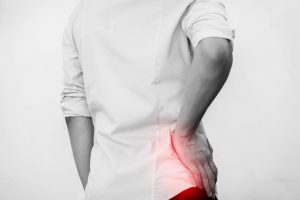Lower Back Pain
 More than 30 million visits were made to physician offices in 2002 because of back problems. Eight out of 10 people will experience back pain at some point in their lives. Low back pain is one of the most frequent problems treated by orthopaedic surgeons. The best strategy to avoid back pain is actively try to maintain a healthy back.
More than 30 million visits were made to physician offices in 2002 because of back problems. Eight out of 10 people will experience back pain at some point in their lives. Low back pain is one of the most frequent problems treated by orthopaedic surgeons. The best strategy to avoid back pain is actively try to maintain a healthy back.
What defines the lower back?
Your lower back is the region below your ribs and above your hips, also known as your lumbar spine, is a complex structure of vertebrae, disks, spinal cord, and nerves, including:
- five bones called lumbar vertebrae – stacked one upon the other, connecting the upper spine to the pelvis
- six shock absorbers called disks – acting both as cushion and stabilizer to protect the lumbar vertebrae
- spinal cord and nerves – the “electric cables” which travel through a central canal in the lumbar vertebrae, connecting your brain to the muscles of your legs
- small joints – allowing functional movement and providing stability
- muscles and ligaments – providing strength and power and at the same time support and stability
WHAT CAUSES LOWER BACK PAIN?
Lower back pain can have multiple causes. The pain most often stems from the spraining or straining a muscle or ligament. There can also be bulging or ruptured discs, compression of nerves, Lordosis, bone misalignment, facet joint arthritis (diagnosed with a medial branch block), or even bone fracture. In some cases if accompanied by other joint pain it could be ankylosing spondylitis.
If chronic pain persists, the patient may need a Radiofrequency Ablation or vertebroplasty.
Lower back pain: Sprain/Strain
A sprain or a strain is often thought of the same thing since the are both partial to full tears of a muscle or ligament, but there is a slight nuance in nomenclature. The word sprain is used when dealing with ligaments and the therm strain is used when dealing with muscles. Despite the term differences they are measured in the same manner.
- Grade 1 – a minor tear consisting of less than 5% of the muscle or ligament. This will not cause a significant loss of strength or motion and will get better quickly with rest, ice, compression, and elevation. You may have Muscle Spasms that accompany any tear of muscle.
- Grade 2 – a more extensive tear than 5% but less than 100%. This will be accompanied by an extensive loss of strength or motion. Recovery will take months, but pain will eventually subside and strength and motion can be recovered in time
- Grade 3 – is a complete tear of the muscle or ligament. This can be accompanied with a deformity as the broken muscle or ligament retract back from the tear and form a lump. The effects of a complete tear can be significant and should absolutely be evaluated by a physician to determine a course of action for recovery
Bulging disc and herniated disc
A bulging disc and a ruptured disc are very similar as they both can involve the same symptoms, but a ruptured disc is more likely to cause more advanced symptoms than a bulging disc. As you age the discs in your back stiffen and dehydrate. The outer parts of your disc can deform with pressure and push out of place; when the outer parts of a disc are displaced but intact it is called a bulging disc. If the bulging disc cracks and the softer inner portions of the disc squeeze out it is called a ruptured, or herniated disc.
A herniated disc has more deformity to the support of the bones and muscles in the area. The contents of the disc protrude out farther and are more likely to rub up against nerves causing pain to travel down the nerve. In the lower back the nerves go down the legs so pain will often radiate down to the calf, or the outer two toes. Any pain that radiates down a limb or causes a loss of strength needs to be evaluated by a physician quickly.

